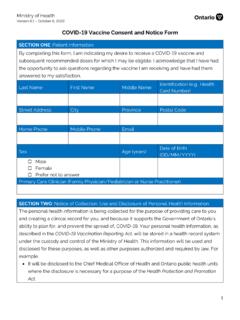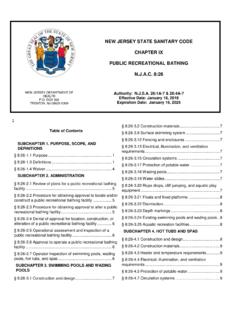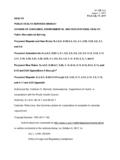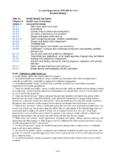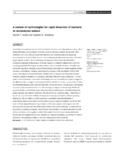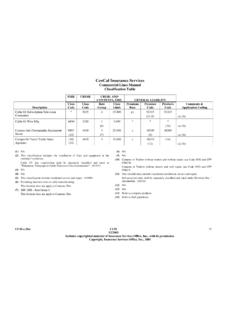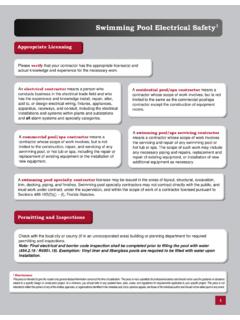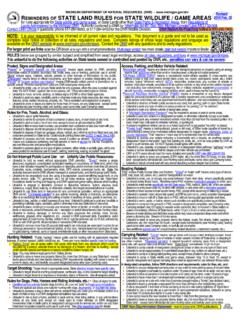Transcription of Operational Approaches for Recreational Water Guideline, 2018
1 Ministry of Health and Long-Term Care Operational Approaches for Recreational Water Guideline, 2018. Population and public Health Division, Ministry of Health and Long-Term Care Effective: January 1, 2018 or upon date of release Operational Approaches for Recreational Water Guideline, 2018. Table of Contents Preamble .. 3. Purpose .. 3. Reference to the Standards .. 3. Seasonal Beach Monitoring Program .. 4. Seasonal Program Planning .. 4. Pre-season Assessment of public Beaches .. 4. Surveillance .. 5. Sampling Methods .. 5. Geometric Mean for Recreational Water Monitoring .. 6. Predictive Modeling .. 7. Communication to the public .. 7. Responding to Adverse Events at public Beaches .. 7. Waterfront Areas at Recreational Camps .. 8. Glossary .. 8. References .. 10. Appendix A: Sample Report .. 11. Appendix B: Calculating the Geometric 13.
2 2. Operational Approaches for Recreational Water Guideline, 2018. Preamble The Ontario public Health Standards: Requirements for Programs, Services, and Accountability (Standards) are published by the Minister of Health and Long-Term Care under the authority of section 7 of the Health Protection and Promotion Act (HPPA) to specify the mandatory health programs and services provided by boards of ,2 The Standards identify the minimum expectations for public health programs and services. Boards of health are accountable for implementing the Standards including the protocols and guidelines that are referenced in the Standards. Guidelines are program and topic- specific documents which provide direction on how boards of health shall approach specific requirement(s) identified within the Standards. Purpose The purpose of this guideline is to provide direction on how boards of health must approach requirements outlined in the Safe Water Standard and the Recreational Water Protocol, 2018 (or as current) to reduce the risk of Water -borne illness and injury related to Recreational Water use at public beaches and waterfronts used by Recreational camps, and achieve consistency for specific program Reference to the Standards This section identifies the standard and requirements to which this guideline relates.
3 Safe Water Requirement 3. The board of health shall ensure the availability of education and training for owners/operators of small drinking Water systems and Recreational Water facilities in accordance with the Operational Approaches for Recreational Water Guideline, 2018 (or as current); the Recreational Water Protocol, 2018 (or as current); the Safe Drinking Water and Fluoride Monitoring Protocol, 2018 (or as current); and the Small Drinking Water Systems Risk Assessment Guideline, 2018 (or as current). Requirement 5. The board of health shall provide all the components of the Safe Water Program in accordance with: a) The Safe Drinking Water and Fluoride Monitoring Protocol, 2018 (or as current) and all applicable statutes and regulations to protect the public from exposure to unsafe drinking Water ; and b) The Operational Approaches for Recreational Water Guideline, 2018 (or as current) and the Recreational Water Protocol, 2018 (or as current), to reduce the risks of illness and injuries at public beaches and Recreational Water facilities.
4 Requirement 8. The board of health shall ensure 24/7 availability to receive reports of and respond to: a) Adverse events related to safe Water , such as reports of adverse drinking Water of drinking Water systems, governed under the Health Protection and Promotion Act or the Safe Drinking Water Act, 2002;. 3. Operational Approaches for Recreational Water Guideline, 2018. b) Reports of Water -borne illnesses or outbreaks;. c) Safe Water issues arising from floods, fires, power outages, or other situations that may affect Water safety; and d) Safe Water issues relating to Recreational Water use including public beaches in accordance with the Infectious Diseases Protocol, 2018 (or as current); Operational Approaches for Recreational Water Guideline, 2018 (or as current); the Recreational Water Protocol, 2018 (or as current); the Safe Drinking Water and Fluoride Monitoring Protocol, 2018 (or as current); and the Small Drinking Water Systems Risk Assessment Guideline, 2018 (or as current).
5 Seasonal Beach Monitoring Program Seasonal Program Planning 1) To support the requirements for monitoring public beaches under the Recreational Water Protocol, 2018 (or as current),3 the board of health shall establish procedures to: a) Confirm the inventory of public beaches within their jurisdiction;. b) Establish the commencement and duration of the monitoring season in consultation with operators;. c) Conduct environmental surveys before the start of the bathing season to collect and assess environmental conditions that may influence Recreational Water quality; and d) Assess the quality of Recreational Water using the geometric mean approach (see the Geometric Mean for Recreational Water Monitoring section below) and the Guidelines for Canadian Recreational Water , 2012 (or as current) for threshold values to guide public health actions, including communicating risk to the Pre-season Assessment of public Beaches 2) The board of health shall carry out a review and analysis of Water sampling data and observations made during the previous season to identify factors that may predict influences on Water quality ( , heavy rainfall).
6 This information may also inform predictive modelling analysis that lead to more timely assessments and communications to the public . 3) The board of health shall carry out pre-season environmental surveys of all public beaches to: a) Identify possible sources of contamination to reduce or eliminate potential impact on Recreational Water quality;. b) Record observations of environmental factors that may influence Recreational Water quality using the Environmental Survey Field Data Report (Appendix A) or equivalent tool; and c) Collect Water samples to assess Recreational Water quality prior to the commencement of the bathing season. 4. Operational Approaches for Recreational Water Guideline, 2018. Surveillance 4) The board of health shall use a routine checklist or reporting tool to document observations and data when Recreational Water quality samples are collected throughout the season.
7 This information will assist in identifying correlations or trends between environmental factors and bacterial Water quality. These conditions shall be observed and recorded during routine public beach sampling to support data analysis. Environmental factors to be observed include: a) Water and ambient air temperature;. b) Rainfall within 24 and 48 hours;. c) Rain intensity;. d) Weather conditions ( cloudy, sunny);. e) Wind speed and direction;. f) Water clarity/turbidity;. g) Wave height;. h) Pollution sources, such as waterfowl, industrial waste discharges, storm Water outflows, septic system discharges, algal blooms and agricultural run-off; and i) Other environmental factors that may be locally significant. The Environmental Survey Field Data Report (Appendix A) may be used to record this information. Sampling Methods public Health Ontario Laboratory Services 5) The board of health shall consult with public Health Ontario Laboratories (PHOL) prior to the start of the sampling program and follow established procedures for submitting samples and communicating test results.
8 Water samples must be labelled and stored in insulated or refrigerated coolers for delivery to the nearest laboratory within one (1) day of collection. For further guidance on sample collection and submission, refer to public Health Ontario's public Health Inspector's Guide to Environmental Microbiological Laboratory Testing, 2017 (or as current).5. Water Sample Collection 6) The board of health shall ensure public health unit staff are trained and adhere to all health and safety precautions to prevent injury or illness when collecting Recreational Water samples at public beaches. 7) Where the depth of Water is 1 to meters, the board of health shall obtain samples for bacteriological analysis 15 to 30 centimeters below the Water surface. When the depth of Water is less than 1 meter, samples shall be obtained as far offshore as possible within the bathing area.
9 Water samples for bacteriological analysis shall be collected using sterile bottles provided by PHOL. For consistent analysis of Water quality, samples should be collected at the same general locations, on the same day of the week, at approximately the same time of day. A diagram of the public beach may be used to ensure the program is consistently applied and includes: 5. Operational Approaches for Recreational Water Guideline, 2018. a) Approximate length of beach;. b) Approximate depth of the Water in the public beach area;. c) Possible sources of pollution and the distances to the bathing area; and d) Numbered sampling points and the sequence the samples are collected. Table 1: Water sampling points are determined by the length of the beach Length of beach Number of sampling points 1000 meters or less 5 points Over 1000 meters 1 point per 200 meters Over 5000 meters 1 point per 500 meters Sampling Frequency 8) For the purposes of Water testing, the board of health shall identify a minimum of five sampling points for each beach.
10 Additional sampling points and more frequent sampling may be carried out as determined by the medical officer of health. Sampling frequency may be reduced to once per month where historical data of the geometric mean and environmental surveys indicate Water quality was consistently within the Water quality threshold for the previous bathing season and confirmed through the pre-season sampling results. Sampling may also be reduced to once per month for public beaches that historically fail to meet Water quality thresholds for previous or entire bathing seasons. In this case, the medical officer of health shall implement a communication strategy to minimize use of the beach by the public ( permanent posting). Geometric Mean for Recreational Water Monitoring 1) The board of health shall review the bacterial test results, as calculated using the geometric mean, along with other environmental factors, to determine appropriate actions.


